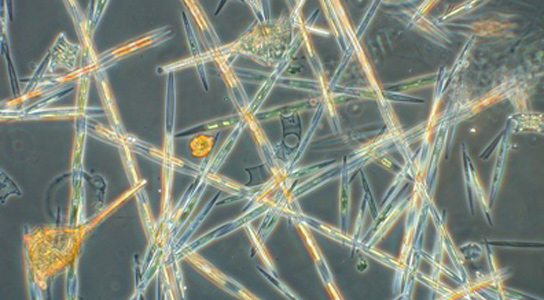
Pseudo-nitzschia is among the species that produce toxins and cause harmful algal blooms. Credit: Courtesy of Raphael Kudela, UCSC
Physical and chemical conditions in the oceans cause populations of algae to wax and wane in cycles. Harmful algae consist of only a few species of diatoms, dinoflagellates, and cyanobacteria. Researchers are wondering what the role of climate change is in the algal blooms that have been seen in the last years.
Some harmful algae create domoic acid, which causes vomiting, cramping, headaches, and even seizures, and memory loss. Others produce saxitoxin, which causes numbness, staggering, and respiratory failure.
Toxic blooms occur naturally when deep, nutrient-rich water swells up in the coasts. They can be amplified by land runoff of fertilizers and other chemicals that provide nutrients, like phosphorous. Algal blooms have been increasing in frequency in coastal waters almost everywhere.
According to the NOAA, in the USA alone, algal blooms have caused $82 million in health costs and economic damages to fisheries as well as tourism. As atmospheric carbon dioxide increases, the greenhouse gas is being absorbed into ocean water, making it more acidic. Marine organisms, like clams and snails, can’t build their calcium carbonate shells or find that they are harder to maintain. This acidification can cause toxic algae to become more nastier and more abundant. Conversely, the organisms might simply adapt without becoming more poisonous; their numbers could even be reduced.
Scientists don’t fully understand the relationship between growth rates, toxin production, and ocean conditions for these algae. Some species will ramp up toxin production as a defense against predators, while others respond to low supplies of crucial nutrients. Toxins could also be a way for these species to store extra nutrients.
Researchers took the diatom Pseudo-nitzschia fraudulenta from southern California waters. This species produces domoic acid. The scientists varied the amount of dissolved CO2 and the availability of silicate the diatoms use to make their shells. They presented their findings at the Third International Symposium on the Ocean in a High CO2 World. They reported that the more CO2 and the less silicate there was, the higher the diatom’s toxin production. It more than doubled at the level of dissolved CO2 scientists expect the oceans to reach by the year 2100.
Water temperature could also be an underlying factor that influences algal blooms. Alexandrium ostenfeldii grew at different rates under increased acidity and higher temperatures. The composition of the toxic compounds changed consistently as temperature and acidity increased.









Be the first to comment on "Toxic Algal Blooms Could be Boosted by Climate Change"